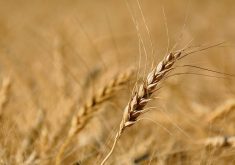A heat wave this week across Western Canada’s canola and grain belt has moderated slightly, and rains forecast into next week should sprinkle some relief onto stressed crops, an agricultural meteorologist said.
Temperatures that were forecast to reach around 35 C by midweek came in slightly cooler in some areas, said meteorologist Andrew Owen of Kansas City-based World Weather Inc., and rain was falling on Thursday morning in western and central Manitoba.
Starting on Sunday a low-pressure system moving across Western Canada looks to drop up to 60 millimetres of rain on southern and central Alberta and lesser amounts across southern and central Saskatchewan and Manitoba by Tuesday, Owen said.
Read Also

Senft to step down as CEO of Seeds Canada
Barry Senft, the founding CEO of the five-year-old Seeds Canada organization is stepping down as of January 2026.
"It will definitely cool things off. There will still be some (areas) that are above-average (temperatures) but nothing near what happened the past few days."
Farmers in the western Prairie provinces planted a record-large area of canola this spring and more wheat than the previous year. Weather conditions have been mostly favorable, but the recent heat came as some canola was in its vulnerable early-flowering stage, leading to damage known as heat blast.
"There’s for sure going to be some heat blast going on," said Angela Brackenreed, an agronomist for the Canola Council of Canada at Brandon, Man.
"It’s been hot across the Prairies, so anywhere the canola is flowering, particularly where it’s just started flowering, is where it will be the most adversely affected."
Some canola crops, such as in south-central Manitoba, were already forming pods and are less vulnerable to the heat.
Canada accounts for about two thirds of the global trade in canola, also called rapeseed, and is the top exporter of spring wheat and durum.
Farmers will not know the extent of the heat damage to canola until the plants form pods, with gaps in places where hot weather caused petals to fall prematurely, said Daphne Cruise, regional crop specialist for the Saskatchewan government. High humidity levels should mitigate some of the losses.
"It all depends on how long (the heat) lasts and how far along the crop is," she said.
Wheat can take the heat better than canola, but hot weather can cause kernels to fill only partially or not at all, said Cruise, who works out of the province’s Agriculture Knowledge Centre at Moose Jaw.
Soil moisture levels in Western Canada are generally adequate after June rains, allowing crops to withstand periods of hot, dry weather better than the drought-ravaged U.S. corn and soybean crops.
Environment Canada issued warnings of severe thunderstorms, possibly including large hail, on Thursday morning for much of southern Manitoba.
— Rod Nickel reports for Reuters from Winnipeg.















